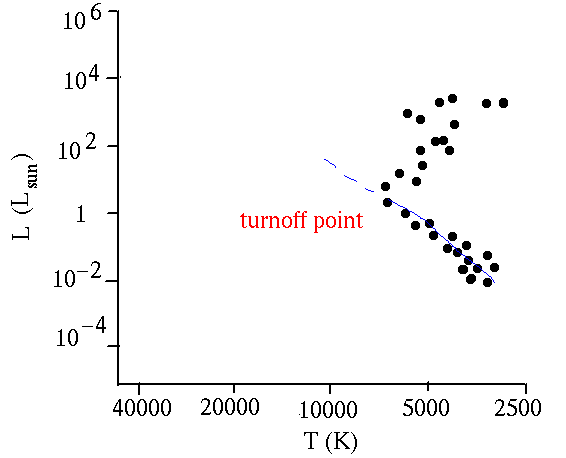Post main sequence stars
The fight against gravity in the cores of stars
During the main sequence lifetime of stars, the energy provided
by burning hydrogen provides the pressure needed to support the
weight of the outer layers.
When the hydrogen is gone in the core, the only available
energy source is gravitational potential energy. The core gets
smaller and hotter as gravitational potential energy is converted
into heat. As this heat begins to leak out, the core shrinks more and
becomes even hotter.
This process can be interupted when the core is dense enough and hot
enough for a new source of fusion energy to take over.
Sources of fusion energy
- 4 1H --> 4He.
- 3 4He --> 12C.
- 12C + 4He --> 16O.
- 12C + 12C --> 24Mg.
- etc. making 28Si, 32S, ...
Production of nuclei beyond C and O takes place only in the heaviest
stars because of the very high temperature and density required.
- H burning lasts a long time. (10 x 109 years in a 1 Msun star, less in heavier stars.)
- He burning doesn't last so long. (2 x 109 years in a 1 Msun star, less in heavier stars.)
- Successive burning stages in very massive stars take less and less
time to complete.
The end of fusion energy
Combining lighter nuclei into heavier nuclei releases energy. But this
stops at iron, 56Fe.
Nuclei heavier than iron can be made, and are made, in very massive stars.
But this uses energy. It doesn't produce energy.
HR tracks for a 1 Msun star and a 5 Msun star

- The 1 Msun star burns H in its core, (red) then He (red).
- The 5 Msun star burns H in its core, (red) then He (red),
then C (red).
- At other (briefer) times, nothing is burning in the cores, which are shrinking. Nuclear burning is occuring only in shells outside the cores.
The theoretical tracks are rather complicated, but in general, the stars
are very bright, their photospheres are big, and the photospheres are
cooler than they were during the main sequence lifetime of the star. This
region is called the red giant region. (Often this region is
subdivided into smaller regions.)
The observational evidence for this comes from looking at the HR
diagrams for star clusters.

Mass loss
During these stages of stellar evolution, stars commonly lose a significant
fraction of their mass by blowing away some of their surface gas in
strong stellar winds.
Davison E. Soper, Institute of Theoretical Science,
University of Oregon, Eugene OR 97403 USA
soper@bovine.uoregon.edu


